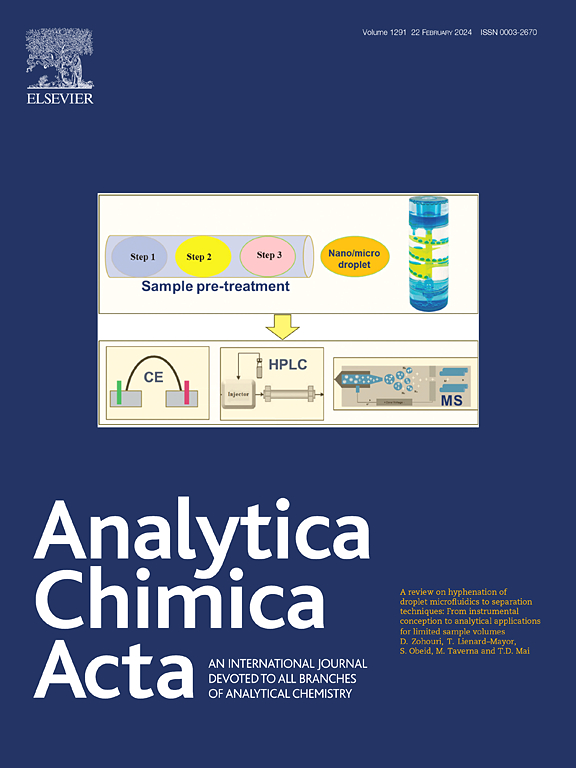手性层叠多孔Co(OH)2的可控合成及其在快速手性识别与分离中的应用
IF 5.7
2区 化学
Q1 CHEMISTRY, ANALYTICAL
引用次数: 0
摘要
手性污染物引起了严重的环境和健康问题,神经毒性氨基酸类似物如β- n -甲氨基- l -丙氨酸(BMAA)在水生生态系统中显示出对映体特异性的生物积累。目前手性环境污染物的分析方法主要依赖于色谱技术,需要大量的样品制备(通常为24小时),限制了现场部署和高通量筛选能力。这些化合物的检测阈值(0.1 - 10 μg/L)需要保持立体化学完整性的敏感方法。本研究通过合理设计具有双模式检测和分离功能的手性氢氧化钴(CF-Co(OH)2)纳米材料来解决这些分析挑战。结果通过胶束模板生长策略获得了手性(R/S/RS构型)和形貌(方形、粗糙表面、雪花状、花状)可调的α-Co(OH)2级孔。该材料具有双重功能:(1)在5分钟内快速比色法鉴别氨基酸,精密度(RSD = 4.9%, n = 6),通过尿l -色氨酸定量(17.1±0.4 μg/mL)验证;(2)采用SPE-HPLC-MS/MS对BMAA进行超灵敏分离,检出限(LOD = 0.02 μg/kg)和处理速度(比常规方法快144倍)显著提高。比色检测机制利用BMAA形成钴胺配合物的能力,产生浓度依赖的黄色,在淡水样品中以50 μg/kg的浓度进行视觉检测。现场试验成功地在鲫鱼中检测到BMAA(0.39±0.03 μg/kg),证实了在不同基质中具有良好的食物链生物放大效果(回收率为90.1 - 102.7%)。该体系的手性特异性表现出明显的亲和模式(BMAA: R-Co(OH)2;DAB: S-Co(OH)2)通过构型特异性“三点结合”机制(分子内结合能:-18.7 kcal/mol)在10 min内产生91.4%的对映体过量。本研究建立了形态可编程手性材料作为快速现场环境监测和高通量毒素分析的多功能分析平台。所开发的方法直接解决了世界卫生组织关于饮用水中藻类毒素检测的指导方针,同时为复杂环境和生物样品中的手性污染物鉴别提供了一种可推广的方法。本文章由计算机程序翻译,如有差异,请以英文原文为准。

Controllable synthesis of chiral hierarchical porous Co(OH)2 and its application in rapid chiral recognition and separation
Background
Chiral pollutants present significant environmental and health concerns, with neurotoxic amino acid analogs like β-N-methylamino-L-alanine (BMAA) demonstrating enantiomer-specific bioaccumulation in aquatic ecosystems. Current analytical approaches for chiral environmental contaminants rely predominantly on chromatographic techniques that require extensive sample preparation (typically 24 h), limiting field deployment and high-throughput screening capabilities. Detection thresholds for these compounds (0.1–10 μg/L) necessitate sensitive methodologies that maintain stereochemical integrity. This study addresses these analytical challenges through the rational design of chiral cobalt hydroxide (CF–Co(OH)2) nanomaterials engineered for dual-mode detection and separation functionality.
Results
A hierarchical porous α-Co(OH)2 with tunable chirality (R/S/RS configurations) and morphologies (square, rough surface, snowflake, flower-like) via micelle-templated growth strategies. The materials demonstrated dual functionality: (1) Rapid colorimetric amino acid discrimination within 5 min with precision (RSD = 4.9 %, n = 6), validated through urinary l-tryptophan quantification (17.1 ± 0.4 μg/mL); (2) Ultrasensitive BMAA separation via SPE-HPLC-MS/MS with significantly improved detection limits (LOD = 0.02 μg/kg) and processing speed (144 × faster than conventional methods). The colorimetric detection mechanism exploits BMAA's ability to form cobalt-amine complexes that produce concentration-dependent yellow coloration, enabling visual detection at 50 μg/kg in freshwater samples. Field testing successfully detected BMAA in crucian carp (0.39 ± 0.03 μg/kg), confirming food-chain biomagnification with excellent recovery (90.1–102.7 %) across diverse matrices. The system's chiral specificity exhibited distinct affinity patterns (BMAA: R–Co(OH)2; DAB: S–Co(OH)2) with 91.4 % enantiomeric excess in just 10 min through configuration-specific “three-point binding” mechanisms (intramolecular binding energy: 18.7 kcal/mol).
Significance
This research establishes morphology-programmable chiral materials as a versatile analytical platform for rapid on-site environmental monitoring and high-throughput toxin analysis. The developed methodology directly addresses World Health Organization guidelines for algal toxin detection in drinking water while providing a generalizable approach for chiral pollutant discrimination in complex environmental and biological samples.
求助全文
通过发布文献求助,成功后即可免费获取论文全文。
去求助
来源期刊

Analytica Chimica Acta
化学-分析化学
CiteScore
10.40
自引率
6.50%
发文量
1081
审稿时长
38 days
期刊介绍:
Analytica Chimica Acta has an open access mirror journal Analytica Chimica Acta: X, sharing the same aims and scope, editorial team, submission system and rigorous peer review.
Analytica Chimica Acta provides a forum for the rapid publication of original research, and critical, comprehensive reviews dealing with all aspects of fundamental and applied modern analytical chemistry. The journal welcomes the submission of research papers which report studies concerning the development of new and significant analytical methodologies. In determining the suitability of submitted articles for publication, particular scrutiny will be placed on the degree of novelty and impact of the research and the extent to which it adds to the existing body of knowledge in analytical chemistry.
 求助内容:
求助内容: 应助结果提醒方式:
应助结果提醒方式:


